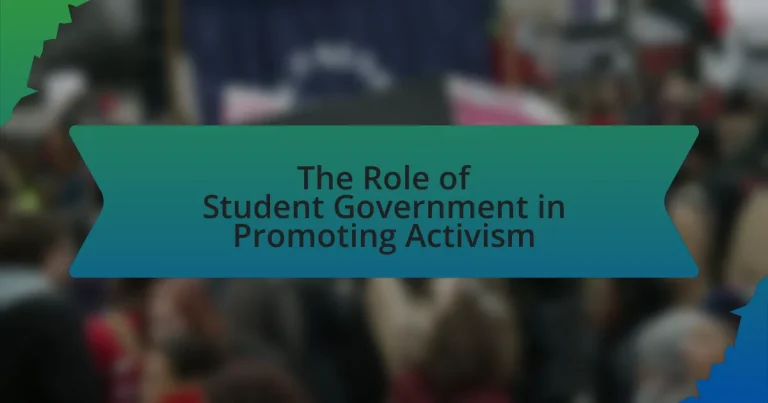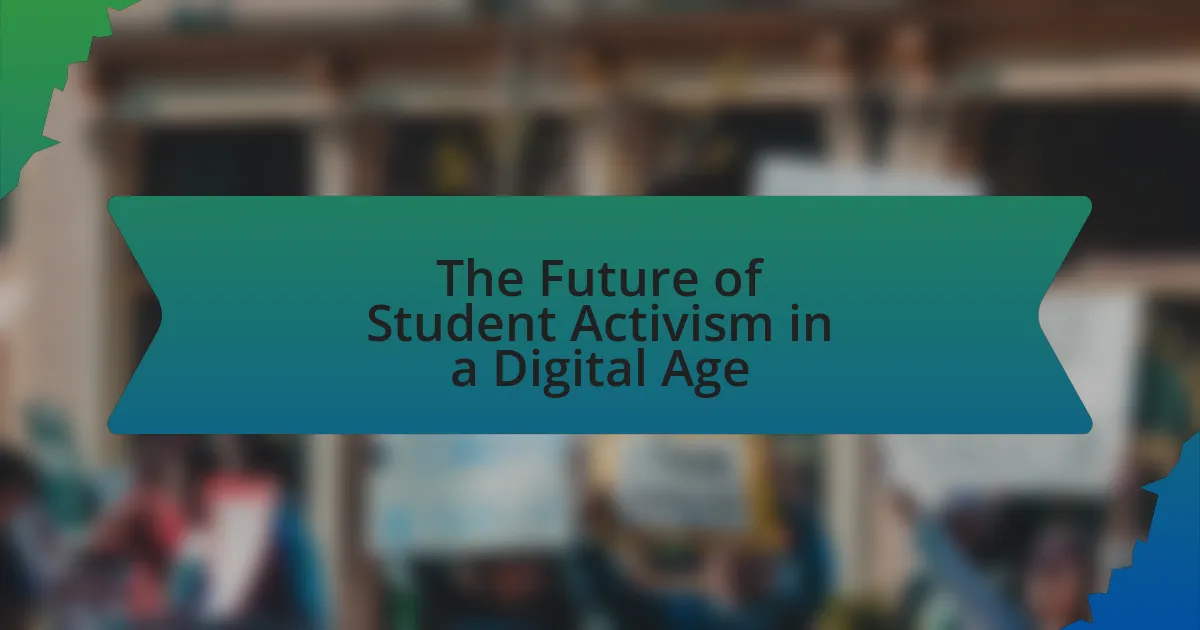Student government serves as a vital platform for promoting activism within educational institutions by amplifying student voices and facilitating organized efforts for social change. The article outlines the key functions of student government, including representing student interests, facilitating communication, and organizing events that raise awareness on social issues. It discusses how student governments influence activism through funding, collaboration with local organizations, and the organization of impactful events. Additionally, the article addresses the challenges faced by student governments, such as limited resources and institutional resistance, while highlighting strategies to enhance student engagement and sustain activism over time.
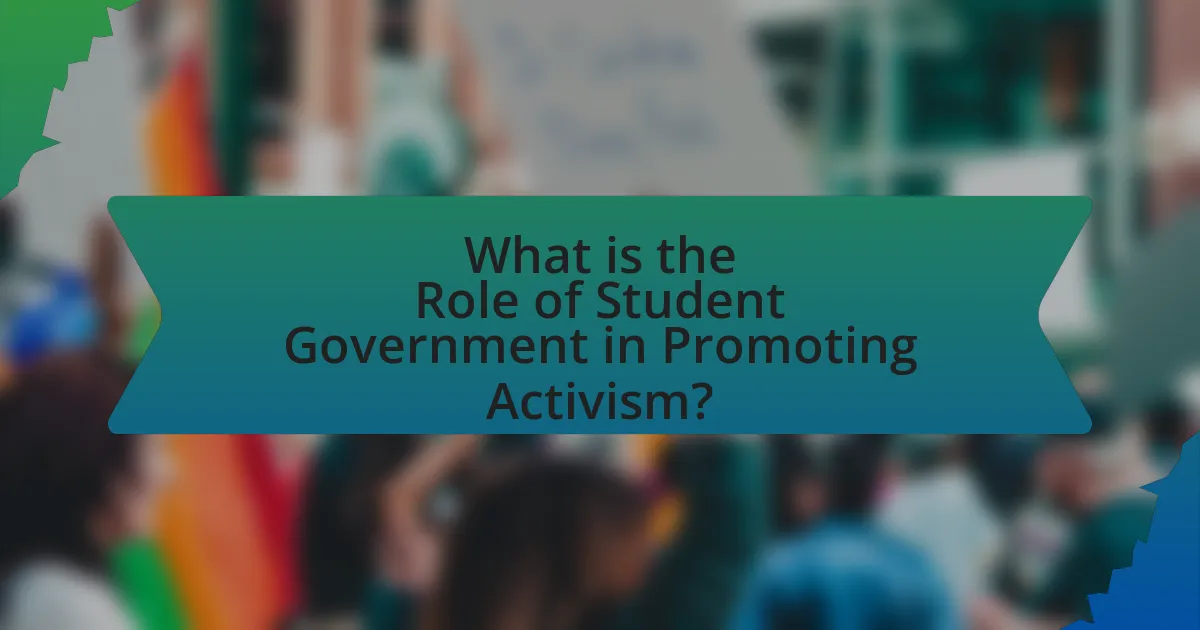
What is the Role of Student Government in Promoting Activism?
Student government plays a crucial role in promoting activism by serving as a platform for student voices and facilitating organized efforts for social change. Through initiatives such as advocacy campaigns, funding for activist groups, and hosting events that raise awareness on various issues, student governments empower their peers to engage in activism. For instance, many student governments allocate budgets specifically for social justice initiatives, enabling students to mobilize around causes like climate change, racial equality, and mental health awareness. This support not only amplifies student concerns but also fosters a culture of civic engagement within educational institutions.
How does student government influence student activism?
Student government influences student activism by providing a structured platform for students to voice their concerns and organize collective actions. Through initiatives such as funding for events, facilitating communication between students and administration, and promoting awareness of social issues, student governments empower students to engage in activism effectively. For instance, a study by the American Association of State Colleges and Universities found that institutions with active student governments report higher levels of student participation in social movements and campus initiatives. This demonstrates that student governments play a crucial role in mobilizing students and fostering a culture of activism within educational institutions.
What are the key functions of student government in this context?
The key functions of student government in promoting activism include representing student interests, facilitating communication between students and administration, and organizing events that raise awareness on social issues. Student governments serve as a voice for the student body, ensuring that their concerns and ideas are heard in institutional decision-making processes. They also create platforms for dialogue and collaboration, which can lead to increased student engagement in activism. Additionally, by organizing events such as rallies, workshops, and campaigns, student governments actively promote social causes and encourage participation in civic activities, thereby fostering a culture of activism within the student community.
How does student government facilitate communication among students?
Student government facilitates communication among students by serving as a representative body that channels student concerns and ideas to administration and peers. This structure allows for organized forums, meetings, and events where students can express their views and engage in dialogue. For instance, many student governments hold regular town hall meetings, which provide a platform for students to voice their opinions and discuss issues affecting their campus experience. Additionally, student government often utilizes social media and newsletters to disseminate information and updates, ensuring that all students are informed and can participate in campus activities. This proactive approach to communication fosters a sense of community and encourages student involvement in governance and activism.
Why is student activism important in educational institutions?
Student activism is important in educational institutions because it empowers students to advocate for their rights and influence institutional policies. This engagement fosters a sense of community and responsibility among students, encouraging them to address social issues such as inequality, environmental concerns, and educational reform. Historical examples, such as the Civil Rights Movement and anti-war protests in the 1960s, illustrate how student activism has led to significant societal changes and policy reforms. Furthermore, research indicates that active participation in advocacy enhances students’ critical thinking and leadership skills, preparing them for future civic engagement.
What impact does student activism have on campus culture?
Student activism significantly shapes campus culture by fostering a sense of community, encouraging dialogue, and promoting social change. This engagement often leads to increased awareness of social issues, as seen in movements like Black Lives Matter and climate activism, which have mobilized students to advocate for policy changes and inclusivity on campuses. Research indicates that campuses with active student organizations report higher levels of student satisfaction and engagement, demonstrating that activism not only influences institutional policies but also enhances the overall educational experience.
How does student activism contribute to social change?
Student activism contributes to social change by mobilizing young people to advocate for issues such as climate justice, racial equality, and educational reform. This mobilization often leads to increased awareness and pressure on policymakers, resulting in tangible legislative changes. For instance, the March for Our Lives movement, initiated by students after the Parkland shooting in 2018, successfully influenced gun control discussions and led to new laws in several states. Additionally, student-led protests have historically played a crucial role in movements like the Civil Rights Movement, where student involvement was pivotal in achieving significant legal reforms.
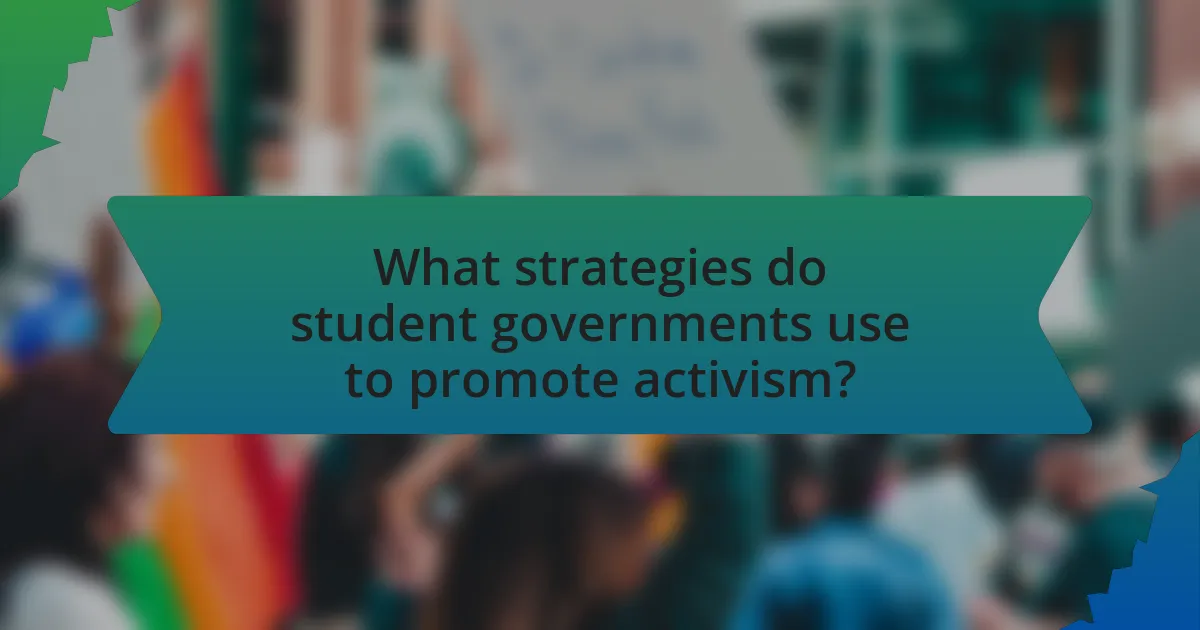
What strategies do student governments use to promote activism?
Student governments promote activism through various strategies, including organizing events, facilitating discussions, and collaborating with local organizations. These entities often host workshops, rallies, and awareness campaigns to engage students and raise awareness about social issues. For instance, a study by the National Association of Student Personnel Administrators found that student-led initiatives significantly increase participation in activism on campuses. Additionally, student governments may provide funding and resources for student organizations focused on activism, thereby enhancing their capacity to mobilize peers. By creating platforms for dialogue and action, student governments effectively foster a culture of activism within educational institutions.
How do student governments organize events for activism?
Student governments organize events for activism by identifying key issues, collaborating with student organizations, and utilizing resources for planning and execution. They typically conduct surveys or hold meetings to gauge student interests and concerns, ensuring that the events resonate with the student body. Collaboration with various student organizations enhances outreach and participation, as these groups often have established networks and expertise in specific areas of activism. Additionally, student governments allocate budgets, secure venues, and promote events through social media and campus communications, which are essential for maximizing attendance and impact. For example, a study by the National Association of Student Personnel Administrators found that events organized by student governments can increase student engagement in social issues by up to 40%.
What types of events are most effective in engaging students?
Interactive events, such as workshops, debates, and hands-on activities, are most effective in engaging students. These types of events foster active participation and collaboration, which are crucial for student involvement. Research indicates that interactive learning environments enhance student motivation and retention of information, as demonstrated in studies like those conducted by the National Training Laboratories, which show that experiential learning methods can lead to retention rates of up to 75%. Additionally, events that incorporate social elements, such as community service projects or social justice forums, also significantly increase student engagement by connecting academic content to real-world issues, thereby promoting a sense of purpose and community involvement.
How do these events foster a sense of community among students?
Events foster a sense of community among students by providing opportunities for collaboration and shared experiences. These gatherings encourage students to engage with one another, build relationships, and develop a collective identity. For instance, participation in events organized by student government, such as rallies or community service projects, often leads to increased social interaction and teamwork, which strengthens bonds among students. Research indicates that involvement in campus activities correlates with higher levels of student satisfaction and a greater sense of belonging, as evidenced by a study from the National Survey of Student Engagement, which found that students who participate in extracurricular activities report feeling more connected to their peers and the institution.
What role does collaboration play in student government activism?
Collaboration is essential in student government activism as it fosters unity and amplifies the voices of diverse student groups. When student government representatives work together with various organizations, they can pool resources, share ideas, and create a more impactful platform for advocacy. For instance, collaborative efforts can lead to successful campaigns on issues such as mental health awareness or campus safety, where multiple student organizations unite to address common concerns. This collective approach not only enhances the effectiveness of activism but also encourages broader participation, ensuring that a wider range of student perspectives is represented in decision-making processes.
How do student governments partner with local organizations?
Student governments partner with local organizations by collaborating on community service projects, advocacy initiatives, and events that benefit both students and the community. These partnerships often involve student governments identifying local needs and aligning them with their goals, such as organizing food drives, environmental clean-ups, or educational workshops. For example, a student government may work with a local food bank to host a food drive, thereby addressing food insecurity while fostering student engagement. Such collaborations enhance community ties and provide students with practical experience in activism and leadership.
What benefits arise from these collaborations?
Collaborations between student governments and activist organizations yield several benefits, including enhanced advocacy effectiveness and increased student engagement. These partnerships allow for pooling of resources, which can amplify the reach and impact of campaigns. For instance, a study by the American Association of State Colleges and Universities found that student-led initiatives in collaboration with local organizations resulted in a 30% increase in participation in civic activities among students. Additionally, such collaborations foster a sense of community and shared purpose, encouraging students to become more active participants in social issues.
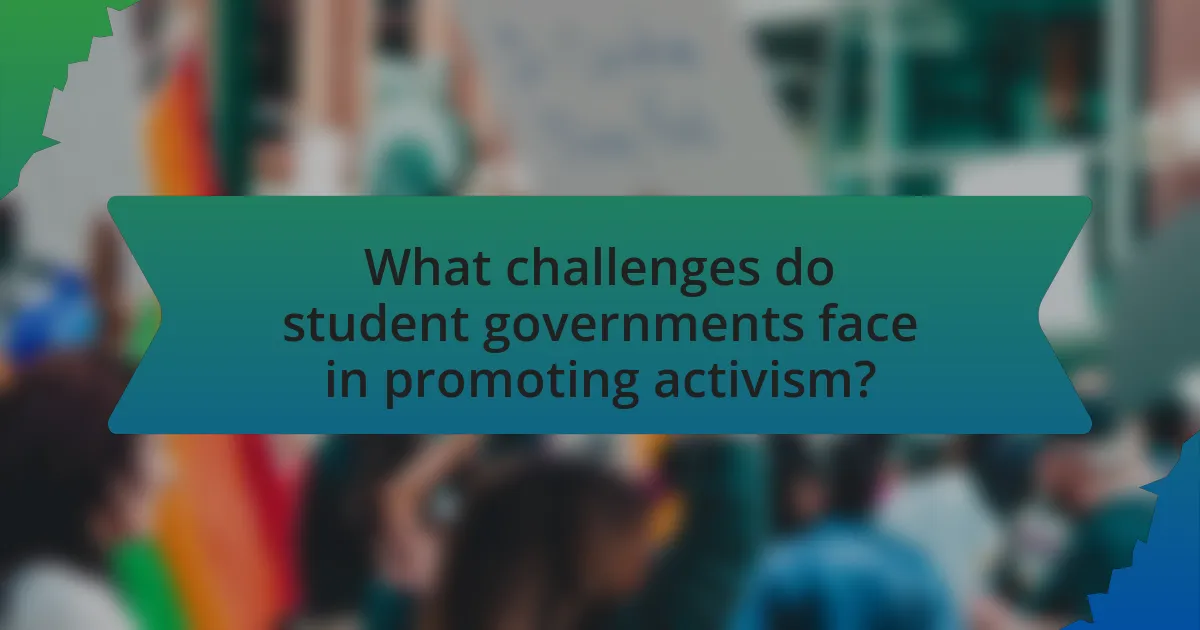
What challenges do student governments face in promoting activism?
Student governments face several challenges in promoting activism, including limited resources, lack of student engagement, and institutional resistance. Limited resources hinder their ability to organize events and campaigns effectively, as many student governments operate on tight budgets. Additionally, a lack of student engagement often results in low participation in activism initiatives, making it difficult for student governments to mobilize support for causes. Institutional resistance from university administrations can further complicate efforts, as policies may restrict the scope of activism or create bureaucratic hurdles that slow down initiatives. These challenges collectively impede the effectiveness of student governments in fostering a vibrant culture of activism on campus.
How do political climates affect student government initiatives?
Political climates significantly influence student government initiatives by shaping the priorities and actions of student leaders. In politically charged environments, student governments often mobilize around social justice issues, reflecting broader societal movements, as seen during the Black Lives Matter protests in 2020, where many student governments advocated for racial equity on campuses. Conversely, in more stable or conservative political climates, student governments may focus on traditional campus issues like funding and events rather than activism. Research from the American Association of State Colleges and Universities indicates that student engagement in governance is often heightened during periods of political unrest, demonstrating a direct correlation between the political landscape and the activism levels within student governments.
What are common obstacles student governments encounter?
Common obstacles student governments encounter include lack of funding, limited student engagement, and bureaucratic challenges. Lack of funding restricts their ability to organize events and initiatives, as many student governments rely on allocated budgets from their institutions. Limited student engagement often results in low participation in elections and activities, making it difficult for student governments to represent the diverse interests of the student body effectively. Bureaucratic challenges arise from navigating institutional policies and procedures, which can hinder timely decision-making and implementation of initiatives. These obstacles collectively impede the effectiveness of student governments in promoting activism and addressing student needs.
How can student governments overcome these challenges?
Student governments can overcome challenges by fostering collaboration among diverse student groups and enhancing communication channels. By creating inclusive platforms for dialogue, student governments can address varying perspectives and needs, which is essential for effective activism. Research indicates that student organizations that engage in collaborative initiatives report higher levels of participation and satisfaction among members, demonstrating the effectiveness of this approach. Additionally, implementing regular feedback mechanisms allows student governments to adapt their strategies based on student input, ensuring that their actions remain relevant and impactful.
What resources are available to support student government activism?
Student government activism is supported by various resources including funding from university budgets, access to administrative support, and training programs. Universities often allocate specific budgets for student organizations, enabling student governments to finance events, campaigns, and initiatives that promote activism. Additionally, administrative support from faculty advisors and university staff can provide guidance and resources for effective activism. Training programs, such as workshops on leadership, advocacy, and public speaking, are frequently offered by universities or external organizations, equipping student leaders with the necessary skills to engage in activism effectively.
How can student governments access funding for activism initiatives?
Student governments can access funding for activism initiatives through various channels, including university grants, fundraising events, and partnerships with local organizations. Universities often allocate specific budgets for student activities, which can be requested through formal proposals detailing the initiative’s goals and expected impact. Additionally, student governments can organize fundraising events, such as bake sales or benefit concerts, to generate funds directly from the student body and community. Collaborating with local non-profits or businesses can also provide financial support or sponsorships, enhancing the initiative’s reach and resources.
What role do faculty and administration play in supporting these efforts?
Faculty and administration play a crucial role in supporting student government efforts in promoting activism by providing guidance, resources, and institutional backing. Faculty members often mentor student leaders, helping them develop skills necessary for effective advocacy and activism. Additionally, administration facilitates access to funding, venues, and communication channels, enabling student governments to organize events and campaigns. For instance, universities that have established formal partnerships between student government and administration have seen increased student engagement in activism, as evidenced by programs that encourage collaborative initiatives. This support not only legitimizes student efforts but also fosters a culture of activism within the academic environment.
What best practices can student governments adopt to enhance activism?
Student governments can enhance activism by fostering inclusive dialogue and collaboration among diverse student groups. By organizing regular forums and workshops, student governments can create platforms for students to voice their concerns and share ideas, which encourages participation and engagement. Research indicates that inclusive decision-making processes lead to higher levels of student involvement, as seen in the 2019 study by the National Student Government Association, which found that institutions with active student engagement initiatives reported a 30% increase in participation in activism-related events. Additionally, providing resources such as funding for student-led initiatives and training in advocacy skills empowers students to take action on issues they care about, further strengthening the culture of activism on campus.
How can student governments effectively engage their peers?
Student governments can effectively engage their peers by implementing inclusive communication strategies and organizing relevant events. By utilizing social media platforms, student governments can reach a wider audience, ensuring that information about initiatives and events is accessible to all students. Research indicates that 79% of college students use social media for campus-related information, highlighting its effectiveness as a communication tool. Additionally, hosting events that address current issues, such as workshops or forums, fosters a sense of community and encourages participation. Engaging students in decision-making processes, such as surveys or focus groups, further enhances their involvement and investment in student government activities.
What strategies can be implemented to sustain activism over time?
To sustain activism over time, student governments can implement strategies such as fostering community engagement, providing resources for education and training, and creating a supportive network for activists. Community engagement can be achieved through regular events that encourage participation and dialogue, which helps maintain momentum and interest. Providing resources, such as workshops on advocacy skills or access to information, equips activists with the tools they need to be effective. Additionally, creating a supportive network allows activists to share experiences and collaborate, which can enhance resilience and commitment to their causes. Research indicates that sustained activism is often linked to strong community ties and ongoing education, as seen in various successful movements throughout history.
